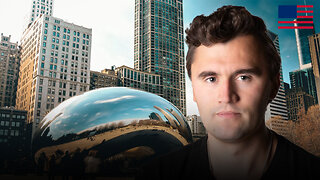Premium Only Content

TLDW #19 - Bladesmithing at the Museum Swordsmith Forge
**WARNING: This is the longer process version intended for serious students of knifemaking.
The sunobe stage is at 4x speed as the hammering was fairly inaccurate due to a blister on my palm from the seam of the yellow gloves...starting material was a harrow tooth, finished blade is hirazukuri, iori mune, 140mm / 5.5" nagasa, 6.5mm motokasane...more info below...
0:20
1. the harrow tooth is first forged into a sunobe, a blade preform, that has a rectangular cross section with the proper thickness and distal tapers for the spine and tang as well as a small notch where the mune machi will be...(dead battery zone)
2. then the iori mune, the peaked spine, is forged...
3:00
3. then the bevels are forged in, working from the machi towards the tip and then back down again, followed by the forging of the tang in this case...during the beveling stage the spine tends to curve upwards so a stump between the anvil and forge is used to make downwards adjustments in advance from time to time, the wood will not mar the peak of the spine...also during this stage water on the anvil keeps the scale from building up and being forged into the surface of the steel...
7:19
4. the nakago (tang) is also shaped and beveled using the same techniques as the blade...
9:11
5. some final planishing, adjustments, and straightening along with a hot stamp "signature" on the tang bring the hizukuri stage to a close...the finish will be tsuchime (hammer texture) so there was no filing/polishing before yaki-ire...
10:16
6. yaki-ire (quenching/hardening) was done at my own forge for the dim and consistent light conditions, allowing the colour to be seen more accurately...
11:10
7. yaki-modoshi (tempering) is a slight reheating to remove some of the stress and increase toughness after hardening...
-
 LIVE
LIVE
Dr Disrespect
2 hours ago🔴LIVE - DR DISRESPECT VS. JEAN-CLAUDE VAN DAMME - HITMAN
1,927 watching -
 LIVE
LIVE
Viss
2 hours ago🔴LIVE - How To Winner Winner Chicken Dinner! - PUBG
160 watching -
 1:00:41
1:00:41
Timcast
2 hours agoTrump MOBILIZING National Guard In NATIONWIDE Crackdown
105K107 -
 LIVE
LIVE
Sean Unpaved
1 hour agoQuarterbacks, Coaches, & Contracts: Sanders' Draft Drama, Meyer vs. Harbaugh, & McLaurin's Big Deal
121 watching -
 2:11:45
2:11:45
Steven Crowder
4 hours agoDonald Trump Vs American Crime: Chicago is Next & Libs Are Freaking Out
250K220 -
 41:08
41:08
Grant Stinchfield
1 hour agoDemocrats Try to Turn California Into Predator Playground with Proposed "Child Predator Dream Bill"
3.57K2 -
 LIVE
LIVE
Rebel News
1 hour agoCdn troops in Ukraine? Poilievre backs self-defence, Hamas thugs cancel Ottawa Pride | Rebel Roundup
416 watching -
 24:58
24:58
Neil McCoy-Ward
1 hour ago⚠️ OUTRAGE! What They Just Announced For YOUR HOME!!! 🚨
3.82K4 -
 LIVE
LIVE
IrishBreakdown
3 hours agoNotre Dame and Miami Set To Reignite Intense Rivalry
502 watching -
 1:57:07
1:57:07
The Charlie Kirk Show
2 hours agoChicago Next! + The Blue Slip Problem | Sen. Tuberville, Alex Clark | 8.25.2025
36.3K11